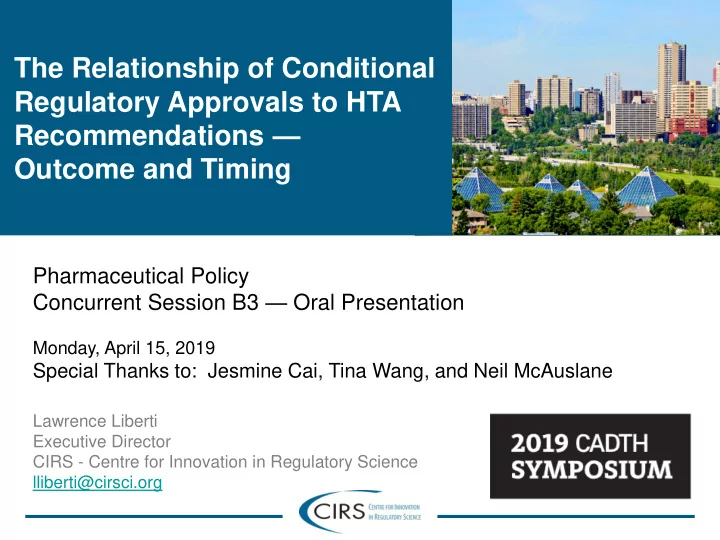

The Relationship of Conditional Regulatory Approvals to HTA Recommendations — Outcome and Timing Pharmaceutical Policy Concurrent Session B3 — Oral Presentation Monday, April 15, 2019 Special Thanks to: Jesmine Cai, Tina Wang, and Neil McAuslane Lawrence Liberti Executive Director CIRS - Centre for Innovation in Regulatory Science lliberti@cirsci.org
Background Over the last decade, there is increasing use of facilitated regulatory pathway (FRP) by regulatory agencies to expedite the review of important new treatments for serious illnesses or addressing unmet medical need Facilitated Regulatory Pathways Regulatory pathway designed to facilitate availability, review and/or approval of medicines where there is an unmet medical need by providing alternatives to standard regulatory review routes ARE HTA RECOMMENDATIONS ALIGNED WITH FRPs TO ENABLE TIMELY ACCESS TO MEANINGFUL NEW MEDICINES?
Study objective Examples of Facilitated Regulatory Pathways US FDA: EU EMA: Health Canada ‐ Accelerated approval ‐ PRIME - Priority review ‐ Breakthrough therapy ‐ Accelerated assessment designation ‐ Conditional marketing - Conditional (Notice of ‐ Fast track authorisation Compliance with conditions) ‐ Regenerative Medicine Advanced ‐ Orphan designation Therapy Designation (RMAT) ‐ Advanced Therapy Medicinal ‐ Priority review designation Product Classification ‐ Orphan designation ‐ Exceptional Circumstances ‐ Rare pediatric disease priority ‐ Adaptive pathways (via EMA HTA review voucher Parallel Scientific Advice) ‐ Real Time Oncology Review (RTOR) The purpose of the study was to investigate the relationship of conditional approvals (including NOC-cs) to HTA recommendations in terms of the HTA outcomes and timing
Study method CIRS HTAdock Database An ongoing programme to monitor regulatory and HTA performance,;data collected for new Data source active substances (NASs) appraised by key HTA agencies, analysing synchronisation between the regulatory decision and first HTA recommendation in timing and outcome. For this presentation, analyses focused on NASs appraised by key HTA agencies from 2015 Datasets in this study to 2017 Data collected on internationalised NASs)were evaluated in terms of: • Type of regulatory review pathways (Standard vs. Conditional) • HTA decisions/ recommendations • Timing of regulatory submission to HTA decisions/recommendations NASs were identified from the CIRS Regulatory Approval Times Database that had: The 1 st HTA recommendation was 1 st HTA recommendation by one of the following Regulatory approval then classified into the following HTA agencies: (2015 to 2017) from both of these categories: agencies: (2012 to CADTH • Positive HAS • 2017) Positive with restrictions IQWIG • Negative EMA • SMC Multiple Health Canada TLV
Study method-Trichotomous categorisation of HTA Decisions Canada England France Germany Scotland Sweden Major Major added benefit benefit Positive General List Accepted Recommended subsidy Important Considerable benefit added benefit Managed Access Moderate Minor added List with Scheme benefit benefit Accepted with Positive with clinical criteria Restricted restrictions and/or restrictions Indications differ subsidy conditions from Market Minor Authorisation Non-quantifiable added benefit benefit No added benefit Do not list at the Negative submitted price proven Lesser No subsidy Not recommended Not recommended benefit Less benefit Do not list/ reimburse Where a green outline indicates that drug Classification as described in CIRS R&D Briefing 69: Cai J, McAuslane N, Liberti L. 2018. R&D Briefing 69: Review of HTA outcomes and timelines in Australia, reimbursement is possible while a red outline Canada and Europe 2014-2017. Centre for Innovation in Regulatory Science. indicates that drug reimbursement is not possible London, UK
Conditional vs. standard approvals in Canada Negative Restriction Positive 100% 4 80% 11 60% 49 40% 20% 6 11 0% Standard (64) Conditional (17)
HTA recommendation - timelines Time from HC submission to CADTH recommendation according to procedure Median, Box : 25 th and 75 th percentiles, Standard Conditional Standard Conditional Standard Conditional 600 500 400 Time (days) [CELLRANGE] [CELLRANGE] 300 [CELLRANGE] [CELLRANGE] 200 252 218 100 [CELLRANGE] 0 [CELLRANGE] -100 HC approval to CADTH CADTH submission to HC submission to HC submission CADTH recommendation approval Number of products submitted through Standard process: 40 Conditional process: 14
Comparison with Europe: 1st HTA Recommendations 2015-2017 Number of NASs with 1 st HTA recommendation in 2015-2017 Negative Restriction Positive Multiple Canada England France Germany Scotland Sweden 100% 1 2 2 4 20 18 80% 5 4 22 29 3 46 11 8 9 60% 49 17 2 40% 20 25 6 20 1 23 29 20% 6 3 3 3 13 1 11 7 5 1 5 0% Standard (64) Conditional (17) Standard (56) Conditional (12) Standard (75) Conditional (12) Standard (68) Conditional (11) Standard (57) Conditional (9) Standard (48) Conditional (5)
Liberti et al: Frontiers Pharmacol. 201 7;8:161
Comparison with US FDA This cohort contained 24 NASs that were approved by • Health Canada in 2015-2017 • FDA Accelerated process in 2015-2017 Out of 12 FDA Accelerated Approval Out of 12 FDA Standard Approval in this cohort, 52% were approved as conditional in this cohort, 100% were approved approval by HC as standard approval by HC [PERCENTAG E] [PERCE NTAGE] 48% HC NOC-Cs HC Standard
Summary (2015-2017) • 21% (17/81) NASs were granted a NOC-C by Health Canada • For NOC-Cs the median time for HC approvals was approximately one month faster than standard approvals. • Median time to CADTH recommendation was only about 2 weeks longer than for standard, but NOC-Cs were more likely to receive an initial negative recommendation. • For Conditional Approvals, positive/positive with restriction recommendations were more frequent in Europe than Canada • This warrants a better understanding of the factors underlying the initial negative recommendations, to better align expedited access recommendations with NOC-Cs.
Recommendation 12 McAuslane et al: he Confluence of Accelerated Regulatory and Health Technology Assessment Access Pathways. CPT Nov 2018
The Relationship of Conditional Regulatory Approvals to HTA Recommendations — Outcome and Timing Pharmaceutical Policy Concurrent Session B3 — Oral Presentation Monday, April 15, 2019 Special Thanks to: Jesmine Cai, Tina Wang, and Neil McAuslane Lawrence Liberti Executive Director CIRS - Centre for Innovation in Regulatory Science lliberti@cirsci.org
Recommend
More recommend